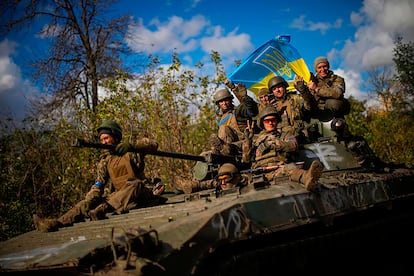Ukrainian army meets little resistance as it approaches city of Kherson
President Volodymyr Zelenskiy celebrates the recapture of ‘dozens’ of towns while his troops are welcomed by residents who were living under Russian occupation

The Ukrainian army is getting closer to Kherson, the only city under Russian control on the western bank of the Dnieper River and whose capture was the Kremlin’s greatest success at the beginning of the war. After a few days of caution, President Volodymyr Zelensky on Tuesday night announced that troops were making “quite fast and significant” advances in the south, where the Kherson region is located. In his daily address, the president cited eight towns in that territory that have been recaptured in the last few hours. He also said that dozens more have returned under Ukrainian control in the regions of Kharkiv, Luhansk and Donetsk.
Until Tuesday, both the government and the army had avoided making triumphant statements. Social media, however, has been circulating videos of Ukrainian soldiers raising the blue and yellow flag in each enclave they recapture. The local residents are seen greeting them and, as in other parts of the country, offering them what little they have.
The Ukrainian advances are taking place on the two open war fronts, in the east and the south of the country. These are occupied territories that belong to one of the four regions (Luhansk, Donetsk, Zaporizhia and Kherson) that Russian President Vladimir Putin unilaterally and illegally declared part of Russia last Friday.
“More and more occupiers are trying to escape,” said Zelenskiy on Monday, in more measured tones than Tuesday. “The advance of our army and all our defenders continued today. There are new liberated enclaves in various regions,” he added, acknowledging that “fierce fighting continues in many areas of the front.”
According to the circulating videos, the Ukrainian army is not meeting excessive resistance from the Russians, whose strategy seems to be to continue launching long-distance missiles against non-military targets. That has been the case in recent hours, with an attack on railway facilities in the city of Kharkiv, in the northeast, in which an employee died on Tuesday, as reported by the national train company. There were also several attacks against the city of Zaporizhia, where 31 people were killed on Friday when Russian troops launched several S-300 missiles against a convoy of civilian vehicles, according to Kyiv.
Russian withdrawal
Late on Tuesday Russian troops launched 114 projectiles without causing fatalities in the Zaporizhia region, as the governor, Oleksandr Staruj, reported on his Telegram channel. This official also underscored the safety hazards for the caravans of vehicles trying to flee the area. If hundreds of residents were leaving every day until this week, increased checkpoint controls by Russian soldiers are slowing down the flow. On Monday, only 43 people were allowed out of Zaporizhia, 11 of them minors. Since Russia now considers these territories its own, it also views its residents as Russians and has ordered the men to enlist to fight on the Kremlin’s side. Growing numbers of men between the ages of 18 and 35 are trying to escape to areas controlled by Kyiv.
In the northeast, Ukrainian troops are gaining positions east of the Oskil River (Kharkiv area) near the border with Luhansk, whose 26,000 square kilometers are almost entirely in Russian hands. The idea is to try to advance towards Luhansk from Kharkiv and from Donetsk, where Ukrainian troops this weekend took over the enclave of Lyman, a strategic point for the supply and logistics of the invading army. The main goal is to recapture the cities of Lisichansk and Severodonetsk (in the Luhansk region), separated only by the Donets River and occupied by the Russians for three months after intense fighting and heavy losses on both sides.
In Kherson, Ukrainian soldiers on Monday took up positions in Dudchani, about 78 miles (125 kilometers) from the regional capital. These advances, like those announced by Zelenskiy on Tuesday, could jeopardize Russia’s goal of keeping its troops on the right bank of the Dnieper River, where Kherson is the only major city they occupy. In addition, Kyiv has bombed and disabled the bridges of that city to prevent Russian troops from withdrawing with weapons and tanks towards the east, where their positions are firmer.
Tu suscripción se está usando en otro dispositivo
¿Quieres añadir otro usuario a tu suscripción?
Si continúas leyendo en este dispositivo, no se podrá leer en el otro.
FlechaTu suscripción se está usando en otro dispositivo y solo puedes acceder a EL PAÍS desde un dispositivo a la vez.
Si quieres compartir tu cuenta, cambia tu suscripción a la modalidad Premium, así podrás añadir otro usuario. Cada uno accederá con su propia cuenta de email, lo que os permitirá personalizar vuestra experiencia en EL PAÍS.
¿Tienes una suscripción de empresa? Accede aquí para contratar más cuentas.
En el caso de no saber quién está usando tu cuenta, te recomendamos cambiar tu contraseña aquí.
Si decides continuar compartiendo tu cuenta, este mensaje se mostrará en tu dispositivo y en el de la otra persona que está usando tu cuenta de forma indefinida, afectando a tu experiencia de lectura. Puedes consultar aquí los términos y condiciones de la suscripción digital.
More information
Últimas noticias
Most viewed
- Oona Chaplin: ‘I told James Cameron that I was living in a treehouse and starting a permaculture project with a friend’
- Reinhard Genzel, Nobel laureate in physics: ‘One-minute videos will never give you the truth’
- Sinaloa Cartel war is taking its toll on Los Chapitos
- Why the price of coffee has skyrocketed: from Brazilian plantations to specialty coffee houses
- Silver prices are going crazy: This is what’s fueling the rally









































